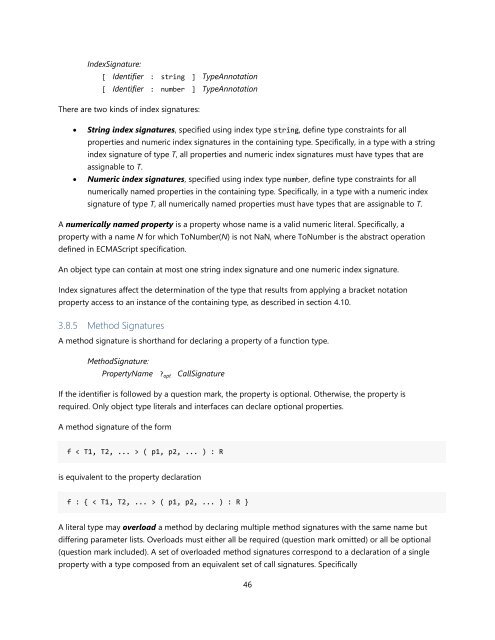TypeScript Language Specification v1.5
TypeScript Language Specification v1.5
TypeScript Language Specification v1.5
Create successful ePaper yourself
Turn your PDF publications into a flip-book with our unique Google optimized e-Paper software.
IndexSignature:<br />
[ Identifier : string ] TypeAnnotation<br />
[ Identifier : number ] TypeAnnotation<br />
There are two kinds of index signatures:<br />
<br />
<br />
String index signatures, specified using index type string, define type constraints for all<br />
properties and numeric index signatures in the containing type. Specifically, in a type with a string<br />
index signature of type T, all properties and numeric index signatures must have types that are<br />
assignable to T.<br />
Numeric index signatures, specified using index type number, define type constraints for all<br />
numerically named properties in the containing type. Specifically, in a type with a numeric index<br />
signature of type T, all numerically named properties must have types that are assignable to T.<br />
A numerically named property is a property whose name is a valid numeric literal. Specifically, a<br />
property with a name N for which ToNumber(N) is not NaN, where ToNumber is the abstract operation<br />
defined in ECMAScript specification.<br />
An object type can contain at most one string index signature and one numeric index signature.<br />
Index signatures affect the determination of the type that results from applying a bracket notation<br />
property access to an instance of the containing type, as described in section 4.10.<br />
3.8.5 Method Signatures<br />
A method signature is shorthand for declaring a property of a function type.<br />
MethodSignature:<br />
PropertyName ? opt CallSignature<br />
If the identifier is followed by a question mark, the property is optional. Otherwise, the property is<br />
required. Only object type literals and interfaces can declare optional properties.<br />
A method signature of the form<br />
f < T1, T2, ... > ( p1, p2, ... ) : R<br />
is equivalent to the property declaration<br />
f : { < T1, T2, ... > ( p1, p2, ... ) : R }<br />
A literal type may overload a method by declaring multiple method signatures with the same name but<br />
differing parameter lists. Overloads must either all be required (question mark omitted) or all be optional<br />
(question mark included). A set of overloaded method signatures correspond to a declaration of a single<br />
property with a type composed from an equivalent set of call signatures. Specifically<br />
46


















